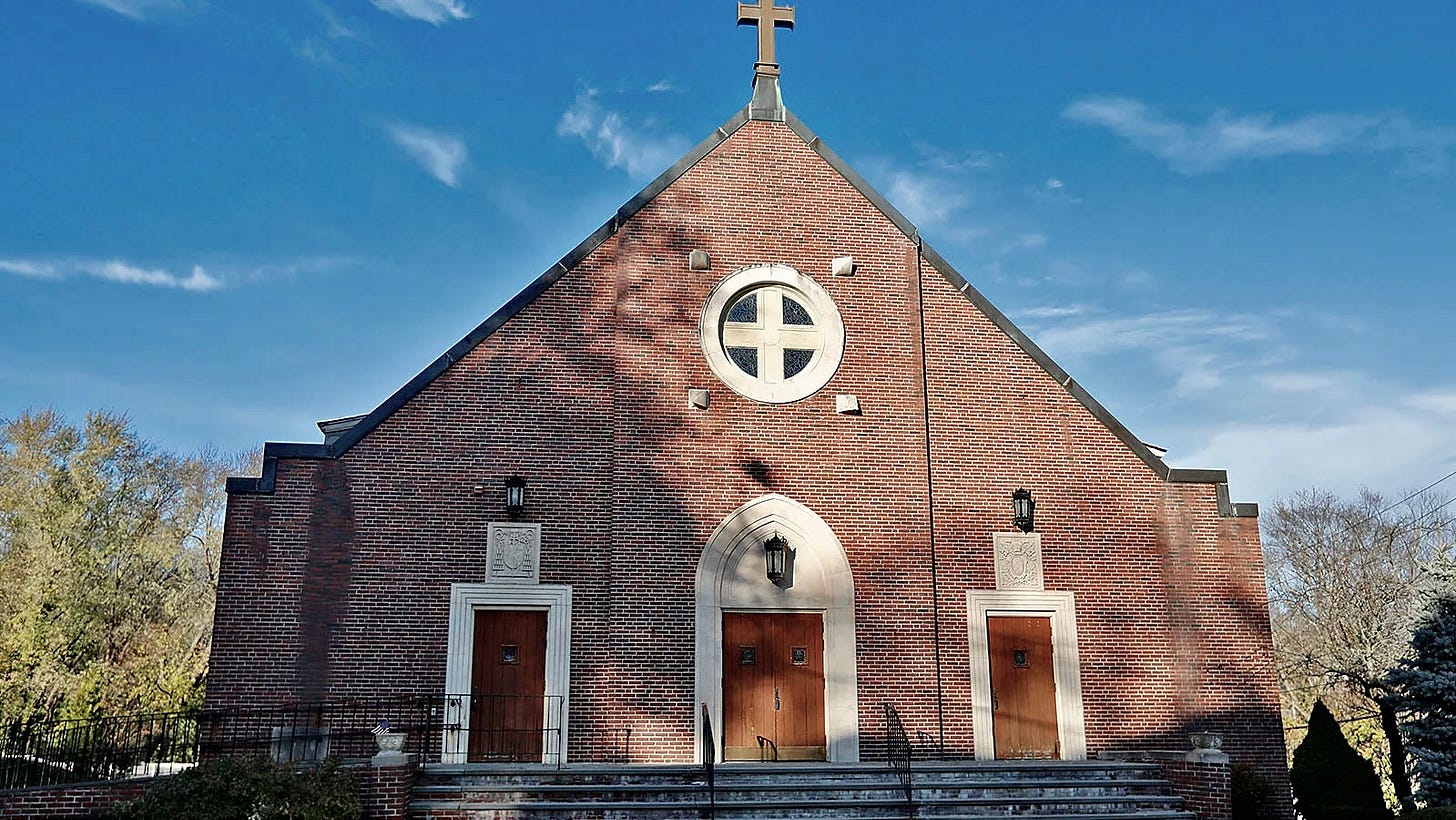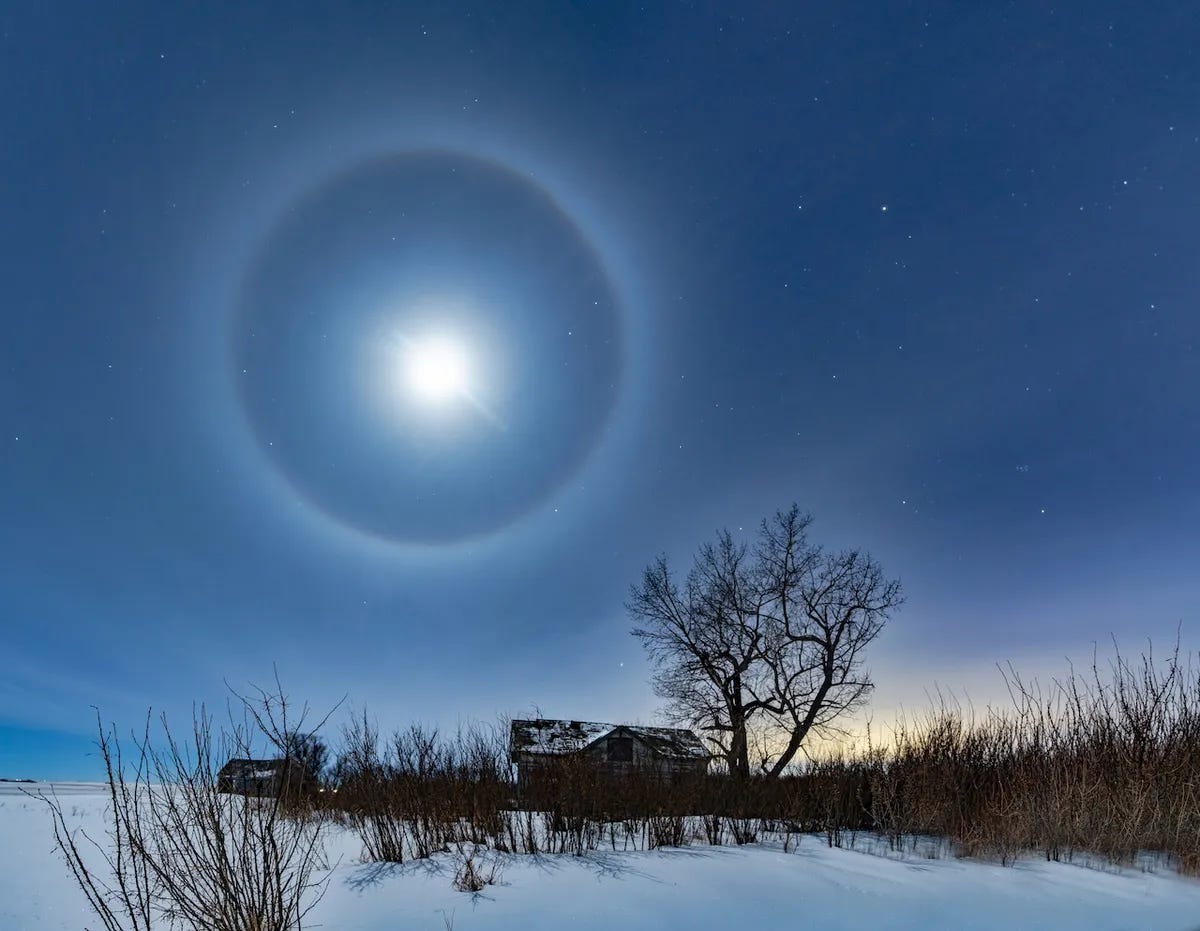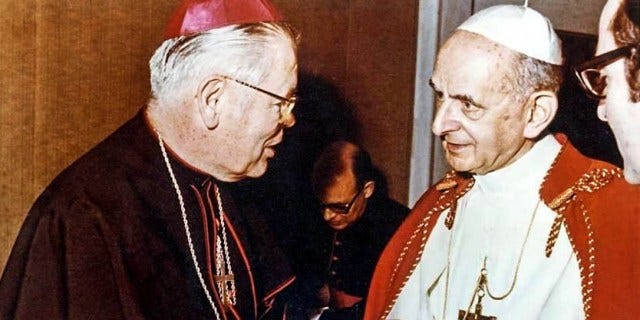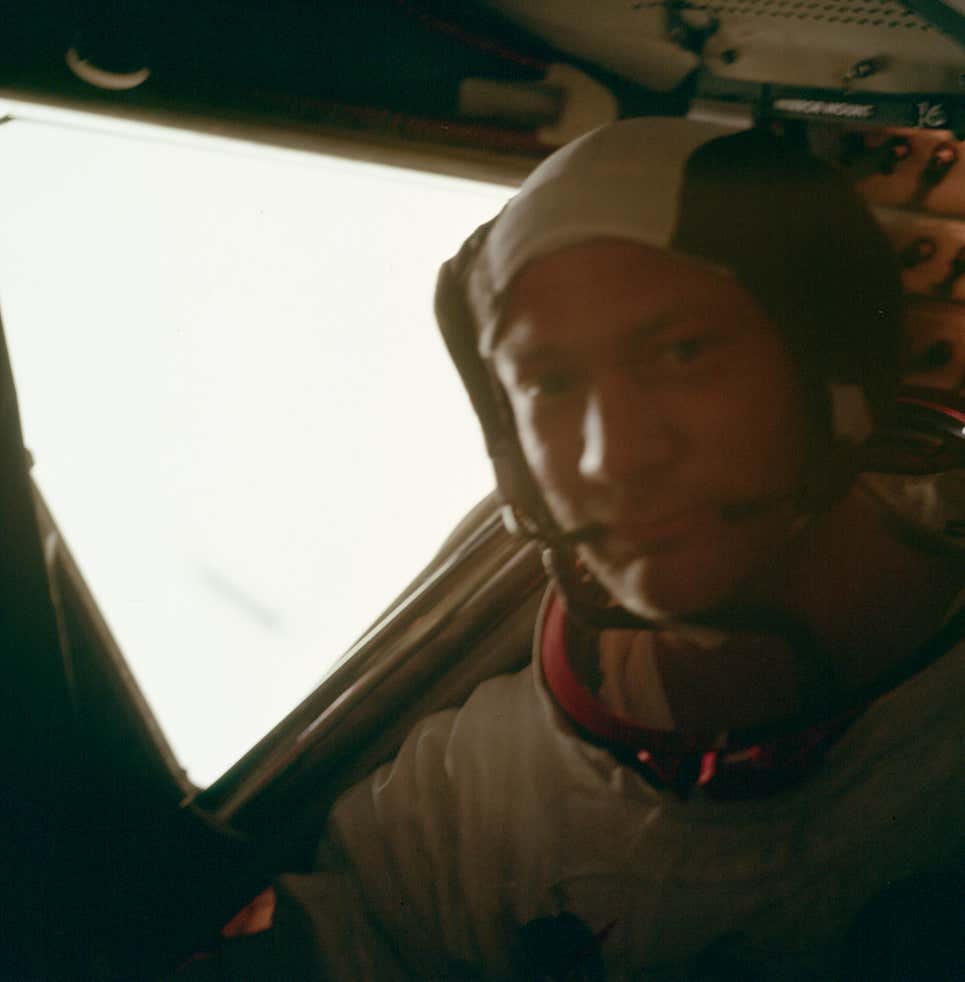COLD MOON 2023
Moon Halo
Dear Lunatics,
For many of us living in the Northern Hemisphere, tonight’s Cold Moon is surrounded by a luminous ring.
They say “Moon halos” are caused by ice crystals in the upper atmosphere.
But maybe, the full moon is just feeling a bit holy this evening.
Here’s an odd fact:
According to the Catholic Church, the Moon falls under the purview of the Diocese of Orlando, Florida.
An arcane line in the 1917 Code of Canon Law stipulates that any newly discovered territory belongs to the bishopric from which the expedition party originated.
Since Apollo 11 launched from Cape Canaveral, Bishop William Borders of Orlando found himself—at 4:17 pm on July 20, 1969—the de facto bishop of our nearest celestial neighbor.
During his next visit to Rome, Bishop Borders boasted to Pope Paul VI that his diocese had recently expanded by 14.5 million square miles.
In subsequent years, many people have taken this boast as tongue-in-cheek. The Church doesn’t actually consider the Bishop of Orlando to be in charge of the Moon—it’s just joking around, right?
I may be able to answer this question from personal experience.
When I was fifteen, I confessed to my priest that I was having doubts about whether the Eucharist was literally the body of Christ. The priest removed his wire-frame glasses and polished them on his purple stole. He asked me if I knew what a mortal sin was. I told him no, but that it didn’t sound good.
Instead of sentencing me to one million Hail Marys, he did something surprising: he offered to make me a Eucharistic Minister. By stationing me at the very center of the sacrament, he wagered that I would feel the presence of the Holy Spirit.
It was a game of ecclesiastical chicken, and I accepted.
For the next three years, I distributed transubstantiated bread and wine every Sunday morning. After communion, I would retire to the sacristy where, per strict instructions, I licked any crumbs stuck to any bowls that had held the Eucharist and swigged (minimum legal drinking age be damned) the dregs of the Precious Blood from the chalices of wine. Then I washed these instruments in a sink whose pipes emptied directly into consecrated ground.
So no, in my experience, the Catholic Church is not joking around.
Neither was Buzz Aldrin.
When we think of astronaut food and drink, what typically springs to mind is a metallic sleeve of freeze-dried ice cream with the consistency of Styrofoam and a tart bottle of Tang. However, in truth, the first liquid and food ever consumed on the Moon were wine and bread.
Upon landing on the southwestern edge of the Sea of Tranquility, Buzz Aldrin and Neil Armstrong didn’t immediately hop out of their lunar module and plant those famous first steps on lunar soil. First, NASA insisted they take a nap. This period of rest and radio silence was intended to give the astronauts a chance to regain their strength after a harrowing four-day space flight.
But Buzz Aldrin didn’t go down for his nap as planned.
Instead, Aldrin reached into a plastic package he’d smuggled into space and withdrew the elements of Holy Communion.
An elder at his Webster Presbyterian Church, Aldrin had been granted special license to celebrate the sacrament during his stay on the Moon. With the intercom off, he said a prayer and administered himself communion while Neil Armstrong observed without comment.
A quarter-century later, the first Eucharistic Minister was launched into orbit. Astronaut Kevin Chilton brought a stack of consecrated hosts inside a golden pyx. On a Sunday in April, as the Space Shuttle Endeavor glided 125 miles above the Pacific Ocean, Chilton led a 10-minute communion service on the flight deck, where he and the two other Catholic astronauts on board hovered weightlessly.
They began the ceremony while on the dark side of the Earth, but just as they ingested their Communion wafers, the Sun came into glorious view.
“Pure radiance from the risen sun streamed through Endeavour's forward cockpit windows and bathed us in its warmth,” one of the communicants, Tom Jones, wrote in his memoir Sky Walking. “What else could this be but a sign?—God's gentle affirmation of our union with Him.”
Talk about feeling the presence of the Holy Spirit.
When I read about the sacrament performed by these spacemen, the former eucharistic minister in me shuddered.
Distributing transubstantiated bread and wine is nerve-wracking work. Every Sunday, I was terrified of spilling the wine or allowing a consecrated host to flutter onto my church’s worn carpet.
But if transferring the host to the waiting tongue of a parishioner is stressful on Earth, just imagine attempting such a feat in microgravity.
What was to stop the host from floating off Chilton’s hand and spinning away into the air, disappearing into some crevice in the space shuttle’s interior?
And what about Buzz Aldrin, tipping his thimbleful of consecrated wine into a tiny chalice while crouched in the lunar lander? In that low-gravity atmosphere, the poured wine might easily have curled up the sides of the cup and filled the lander with floating violet globules.
Yet both Chilton and Aldrin pulled their respective ceremonies off without incident. Like all astronauts, they must have had steady hands.

At the time, Aldrin’s plan to take communion on the Moon caused a stir among NASA officials. They asked him to keep his religious ceremony private and his broadcast comments “more general.”
Aldrin himself later expressed regret for his actions.
In his 2009 memoir, Magnificent Desolation: The Long Journey Home from the Moon, he wrote:
Perhaps, if I had it to do over again, I would not choose to celebrate communion. Although it was a deeply meaningful experience for me, it was a Christian sacrament, and we had come to the moon in the name of all mankind—be they Christians, Jews, Muslims, animists, agnostics, or atheists.
I’ve had my own second thoughts about the sacrament. I had just left for college when The Boston Globe exposed the child sex abuse scandal in the Boston Archdiocese.
From a dorm room at my Jesuit university, I quietly researched how to be excommunicated. I wanted out. I remember scrolling through Canon Law online and finding nothing solid. How many wives do I have to behead? I wondered.
Eventually, I discovered the truth. Once you’ve been baptized, the watermark never fades—the Church considers you a member for life (and afterlife, for that matter).
For years, I never stepped across the threshold of a Church. Yet every Sunday morning I felt as though I were supposed to be somewhere. My faith prickled like a phantom limb.
And then one day, long after I’d returned to my hometown, I confronted the fact that every last one of my socks had worn through at the heel and decided to drive to my local department store.
Leaning over a bargain bin, I experienced the physical certainty that someone was staring at me. When I looked up, I met the sad, searching gaze of an old man who was standing about twenty feet away by a clothing rack, shifting from foot to foot, plainly debating whether to approach me. I grabbed a package of socks and darted into sportswear.
What ensued was one of those slow-motion chases you wade through in nightmares. Every corner display I rounded, there the stranger was. At times he seemed on the verge of calling out to me, but something held him back, as though what he had to say to me could only be whispered.
With slow, shuffling steps, he tried resolutely to close the distance between us. But I never let him.
It wasn’t until I was driving home that I was able to place my pursuer.
It was my old priest.
The one who made me a Eucharistic Minister all those years ago.
The one who tried to save my soul.
And I hadn’t recognized him.

They say there are no atheists in foxholes.
But what about in lunar craters?
Before our decade is out, NASA plans to establish a permanent base on the Moon to serve as a springboard for missions to Mars and beyond.
I’ve studied many proposed schematics for lunar outposts, and I’ve yet to see any plan that includes a nondenominational moon chapel.
In the 21st century, space exploration is a largely secular enterprise, as long as you don’t count the Greek and Roman gods still evoked in the names of missions and rockets that soar into the sky like fiery chariots.
The assumption (spoken or unspoken) is that once humans become an interstellar species, we will leave religion—with its superstitions and strange ceremonies—behind on Earth.
But I’m not sure the religious imagination can be cut loose like a sandbag from a hot air balloon.
Maybe it was all those Sunday mornings I spent in a now-shuttered church, administering the Eucharist while bathed in a tropical, underwater light streaming through stained glass, but I have no trouble imagining Jesus in outer space.
I can see him resisting the temptations of Satan after fasting for 40 days and 40 nights on the dark side of the Moon.
I can see him delivering the Sermon on the Mount while sitting cross-legged on the lip of a lunar volcano.
And I can see him wandering the deserts of Mars, walking across canyons and dry lake beds as dust storms churn on the horizon, a shepherd with no flock aside from the occasional rover. And I can see stretched behind him, where his heavy crucifix dragged, a long line left in the red sand.
Whatever your creed or credo, I think we can all celebrate the final full moon of 2023.
See you all in 2024 on the Wolf Moon!
—WD








This secular Jew-slash-atheist enjoyed your piece.
Faith like a phantom limb. 🖤🌕